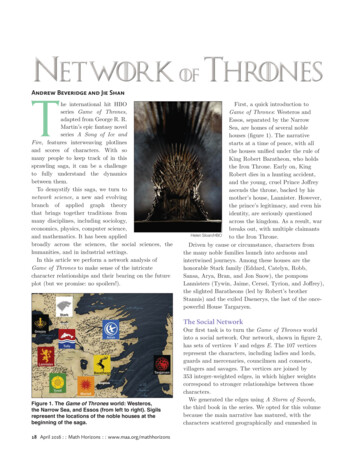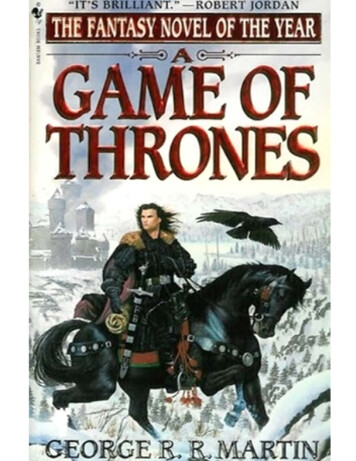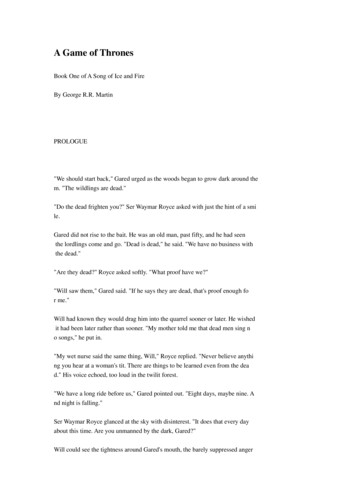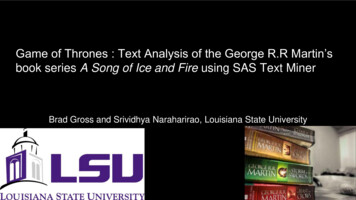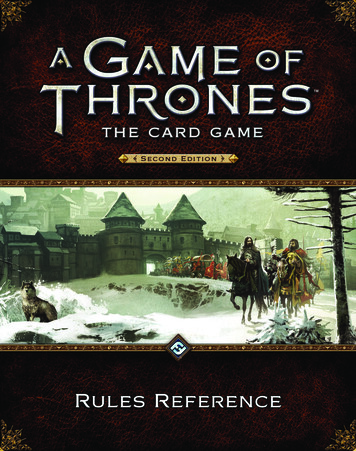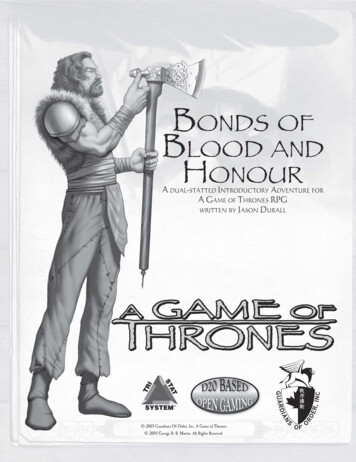
Transcription
A Game of Thrones:The Board GameA game for 3-5 players designed by Christian T.Petersen, based on the bestselling A Song of Ice & Firenovels by George R.R. Martin. Playing time: 2-4 hours.Welcome to WesterosKing Robert Baratheon is dead, and the lands ofWesteros brace for war. House Lannister, whose daughter Cersei was Robert’s queen, claims the throne for heryoung son Joffrey. Stannis Baratheon, knowing thatRobert was not the true father of Joffery, rightfullyclaims the throne for himself. On the Iron Isles, HouseGreyjoy is about to embark on its second rebellion, butthis time with a much grander goal. In the north, HouseStark gathers its strength to defend what is right, and inthe south the wealthy House Tyrell harbors an old ambition to sit on the Iron Throne. As armies gather andravens fly, a clash of kings is inevitable.IntroductionThank you for acquiring the A GAME OF THRONESboard game. You are about to immerse yourself inGeorge R.R. Martin's exciting world of kings andqueens, knights and ladies, swords and boiled leather. Anepic tale set in a harsh land with a dark legacy.As a player in the A GAME OF THRONES board game,you will control one of the great noble Houses:Lannister, Stark, Baratheon, Tyrrell, or Greyjoy. Withplanning, diplomacy, and clever card play, you will seekto control the most Strongholds and Cities to finallyclaim the Iron Throne for yourself and your House.Game ObjectiveThe A GAME OF THRONES board game is played over10 turns. At the end of game turn 10, the player whocontrols the most Cities and Strongholds on the gameboard wins the game.Number of PlayersThe A GAME OF THRONES board game is designedspecifically for 5 players. The game can also be easily beplayed with 3 or 4 players, however. See the specialrules in the back of this rules set for that apply to 3 and 4player games.5 cardboard Supply tokens (1 per House)35 House Cards (7 for each house)5 House Start Cards (1 for each house)30 Westeros Cards50 Wooden Footmen units20 Wooden Knight units30 Wooden Ship units1 "Wildling" token1 "King’s Landing" token1 "Eyrie" token1 "Sunspear" token1 Cardboard Valyrian Steel Blade token1 Cardboard Messenger Raven token1 Cardboard Iron Throne token1 Mapboard1 Turn order token1 Rules setThe Footmen, Ships, and KnightsThese wooden counters represent the military might ofyour House.FootmanKnightShipThe House CardsEach house receives seven unique House Cards whichrepresent important characters from A Song of Ice andFire. These characters are used as leaders in your battlesagainst rival houses.Before you play the game for the first time, carefullypunch out the cardboard tokens from their frames so thatthey do not tear.The Order CountersEach house is provided 15 round order counters, 3 eachof March, Support, Raid, Consolidate Power, andDefense. These are used during the Planning Phase togive hidden orders to your Knights, Footmen, and Shipson the board.MarchSupportConsolidatePowerRaidThe Westeros CardsThese cards are divided into three distinct groups (I, II,and III), and represent’s special events and mundanetasks during the Westeros Phase.DefenseThe Power CountersThese shield-shaped counters represent your politicaland economic influence among the people and minornobles of Westeros. You use these counters to bid forposition on the Areas of Influence, to support the Night'sWatch against the wildling attacks, and to establish control on the board.ComponentsEnclosed in this box you will find the followingcomponents:75 cardboard order counters (15 per house).100 cardboard Power tokens (20 per house)15 cardboard Influence tokens (3 per house)Page 2The House Start CardsBefore the game begins each player is provided with aHouse Start Card. This card describes that House's starting units and provides the initial placement for thathouse on the Areas of Influence and the Supply track.This card is only used for setup and has no function inthe game itself.
The Iron Throne, Valyrian Steel Blade, andMessenger Raven tokens.ly face down next to the game board.9) Players now set up their starting units and tokens asinstructed by their House Start Cards. This is done in thefollowing three steps:a) Each player places his octagon-shaped Influencetokens on his starting position on each of the three Areasof Influence.These three large cardboard tokens are awarded to thestrongest player in each of the three Areas of Influence(The Iron Throne, The Fiefdoms, and the King's Court).These oversize tokens provide their owner with specialpowers in the game.b) Each player nowreceives 5 Powertokens from thePower Pool.NOTE: Whenevera player receivesa Power tokenfrom the PowerPool, he mustExample of Game SetupThe Game BoardThe main feature of the A GAME OF THRONES boardgame is the game board. The board is divided into several sections, the largest of which represents Westerositself divided into a number of Land and Sea areas. Theother sections of the board are: The Wildling Attacktrack, the three Areas of Influence, the Supply track, andthe Game Turn track.Game SetupBefore you start playing, follow these instructions to setup the game.1) Unfold the board and place it centrally on a largetable.2) Place the Kings Landing, Eyrie, and Sunspear tokenson their respective areas on the board (these representneutral forces in these areas).3) Place the Wildling Attack token on the "0" space onthe Wildling Attack track in the north of Westeros.4) Place the Turn Order token on "Turn 1"5) Place all the Power tokens (for all the Houses) in alarge pile next to the game board. This pile of availablePower tokens is also called the Power Pool.6) Each player now randomly draws a House Start Cardto determine which house he will control for the rest ofthe game.7) Each player takes the 7 House Cards that correspondto his House.After drawing the Lannister Start Card (whichindicates that the player will control that house),the Lannister player now reads the setup instructions on that card.Following the instructions, he does the following:First, he places a Footman and a Knight onLannisport, a single Footman on Stoney Sept,and a Ship on the Golden Sound.After his starting units are placed, the Lannisterplayer notes his starting positions on the Areas ofInfluence and places his octagonal Influencetokens on position 2 in the Iron Throne Influence8) Separate the three decks of Westeros Cards (each separate deck is indicated by a roman numeral I, II, or III).Shuffle each of the three decks and place them separatePage 3Area, position 5 in the Fiefdoms Influences area,and finally position 1 on the King’s CourtInfluence Area.The Lannister player also takes the MessengerRaven special token (since he starts at the topposition on the King’s Court).The Lannister player now places his House Cards,5 available Power, the Messenger Raven, and hisunused units in front of him and places theLannister Start Card back in the box (it is nolonger needed).House Lannister is now ready to start the game.
always take a Power token that represents his house (ie.a Stark player may never take a Lannister Power token).Power tokens in a player’s possession are called available power. Available power must be kept visible for allplayers to see (except when bidding).c) Each player now places his starting units (Footmen,Knights, and Ships) in the areas indicated by his HouseStart Card.The game setup is now complete and the game is readyto commence.The Turn SequenceThe A GAME OF THRONES board game is played over10 whole game turns, with each game turn separated intothree phases played in the following order:1) The Westeros Phase (skipped on Game Turn 1)2) The Planning Phase3) The Action PhaseAfter the Action Phase on game turn 10, the game isover and the player who controls the areas containing themost cities and strongholds wins the game (explained indetail later).The Westeros PhaseThe Westeros Phase represents special events and mundane activities in Westeros. This phase is skipped on thefirst turn, when play should proceed directly to thePlanning Phase.The Westeros Phase is split into following steps:1) Advance the Turn Order token2) Reveal the top card on each of thethree Westeros decks3) Resolve the top card on deck I4) Resolve the top card on deck II5) Resolve the top card on deck III6) Place the three resolved Westeros cardson the bottom of their respective decks.7) Proceed to the Planning PhaseThe Westeros CardsThere are three decks of Westeros Cards (I, II, and II).During each Westeros Phase, the top cards of all threedecks are revealed simultaneously and then resolved inorder (starting with I). Players resolve cards by following the instructions for each card as outlined below or onthe back page of this rules sheet.The rules for each Westeros Card is summarized on theback page of this rules sheet. Four cards, however,require a more detailed explanation. These cards are:Supply, Mustering, Clash of Kings, and Wildling Attack.These cards are explaned below:SupplyArmies require anenormous amount ofsupplies: food, water,steel, horses, clothing, etc. Even in themodern day, it is afact that an army canonly be as large as itssupplies allow. Without adequate supply, an army willquickly deteriorate and its warriors scatter. In the AGAME OF THRONES board game, the Supply Trackcreates a relevance between a house's armies and itsaccess to supplies.ArmiesAn army is defined as 2 or more of your units sharingthe same area. This also applies to two or more of yourShips in the same Sea area (which also is called a fleet). Note that Knights, even though they are stronger thanfootmen, only count as one unit for purposes of Supply. The more areas you control that contain Supply icons,the more supply you will have, and thus the ability tomaintain more and larger Armies. Blackwater, for example, provides you with two Supply icons, and may therefore be a contested location.Controlling a LocationA house is said to control a Land area when it has atleast one Footman or Knight in the area, or has previously established control (placed a Power token) in thatarea. Rules for establishing control are found later in thisrules set.To resolve the Supply Card in the Westeros Phase, eachplayer, in order of play, counts the number of Supplyicons in the areas that he controls and then adjusts theSupply tokens on the Supply track to reflect his newSupply reality.Order of PlayThe Supply iconThe order of play is the order of houses as they are represented on the Iron Throne track in the Areas ofInfluence. The first (leftmost) house, starts, followed bythe second (second from left) house, etc.The Supply track is located on the game board and indicates how many, and how large, the armies of eachhouse may be. A player receives one step on the SupplyTrack for every Supply icon present in areas under hiscontrol.Below every Supply step on the Supply track are a number of banners. These banners illustrate the number ofarmies that this level of supply allows. The numberinside each banner represents the maximum number ofunits that this army may have.Page 4If a player has lost Supply icons on the board, it is possible that his armies on the board now exceed his Supplyallowance. If you have more and/or larger armies thanyour new supply allows, you must remove units from theboard until the number/size of your armies match yourallowed Supply (see example).
Example of change in SupplyImportant Note:Even though youmay gain or loseSupply icons onthe board during the ActionPhase, changein Supply isonly reflectedon the Supplytrack when theSupply card isdrawn andresolved during theWesteros Phase.MusteringBefore the previous turn, House Lannister had aSupply of 5, but last turn lost control of theRiverrun and Seagard areas to the Greyjoy player(each area contains a single Supply icon). Duringthe next Westeros Phase, a Supply card is revealed.Lannister must now adjust his Supply from a valueof 5 to a value of 3.Before the effects of declining Supply are resolved,Lannister fielded four Armies: a 4, 3, 2, and 2 asdescribed below: One army of 2 Knights and 2 Footmen (atHarrenhal) (4) One army of 3 Ships (in the Golden Sound) (3) One army of 2 Knights (at the SearoadMarches) (2)One army of 2 Footmen (at Stoney Sept) (2)House Lannister also controls several other areascontaining a single Footmen unit in each, but single units do not form an army and so do not counttowards Supply limits (they are said to be “livingof the land”).Now that the Lannister Supply has dropped to 3(after losing the two Supply to Greyjoy) he can nolonger adequately supply some of his armies. Asindicated on the Supply track, a Supply of 3 allowsyou to field 4 armies with the sizes: 3,2,2,2. Toconform to this new supply reality, Lannisterdestroys one of his ships in the Golden Sound andone of his Footmen from the army at Harrenhal.His armies now look like this: One army of 2 Knights and 1 Footman (3) One army of 2 Ships (2) One army of 2 Knights (2) One army of 2 Footmen (2)Thus, as a result of losing Supply, Lannister had todestroy 2 units and cannot field larger armies untilhe gains control over more Supply icons (and hisSupply token is adjusted during a future WesterosPhase Supply card).Page 5This card reflects the efforts of the great houses to callupon their bannermen, train warriors, and build mightyships. A Mustering card is resolved in the followingmanner:In Order of Play, each player musters all his new units(Footmen, Knights, and Ships) using mustering pointsfrom the Cities and Strongholds under his control.StrongholdCityA Stronghold provides 2 mustering points.A City provides 1 mustering point.
The UnitsThere are three types of units in A GAME OFTHRONES: The FOOTMAN, the KNIGHT, and theSHIP. Each costs the following amount of musteringpoints:FootmanKnightShipUpgrade a Footman to a KnightFootmanKnightExample of Mustering1 Point2 Points1 Point1 Point*Ship* A Footman already in play may be upgraded to aKnight for 1 mustering point. Such an upgrade must takeplace in a City or Stronghold and uses the muster pointsof that City or Stronghold. A Footman located in an areawithout a City or Stronghold may not be upgraded.New units are placed directly in the area of theCity/Stronghold that provided the mustering points.Ships are placed in any Sea area adjacent to the areacontaining the mustering City/Stronghold. If such a Seaarea is occupied by ships from another house, you maynot muster a ship there.After a player has completed all his mustering, the nextplayer in the order of play starts his mustering.VERY IMPORTANT NOTE: A player may nevermuster a new unit so that it creates an army thatexceeds his Supply limit. If playing a new unit in anyof your Cities/Strongholds will cause you to havemore, or larger, armies than allowed by the Supplytrack, you may not Muster that unit. Remember that you must use a City/Stronghold's mustering points to create a new unit in that specificCity/Stronghold's area and not elsewhere. If you cannotcreate new units due to short Supply, those unused mustering points are lost.A mustering card is revealed during a newWesteros Phase. The Lannister player (Supply of 3)is the first player in the order of play and nowmusters his new units.For the 2 mustering points for Lannisport (whichcurrently holds 1 Footman), he places 1 additionalFootman at Lannisport (creating an army of 2Footmen), and one Ship in the Golden Sound,which was previously empty.Turning his attention to Harrenhal, he uses its single mustering point to upgrade one of his twoFootmen here to a Knight (upgrading does notaffect the army size).Since he already has an army of 3 Knights atClash Of Kings Each house has 10 Footmen, 4 Knights, and 5 Ships. Ifa player is using all the units of a particular type, he maynot create additional units of this type. Units that arekilled in battle, or removed from the board for any otherreason, become available for mustering once more.Riverrun, he uses one of his mustering points atRiverrun to place another ship in the Golden Sound(which is also adjacent to Riverrun), creatinganother army (fleet) of 2 ships. He cannot use the 1remaining mustering point at Riverrun since he hasmet his Supply limits everywhere.The Lannister player now has an army of 3Knights at Riverrun, an army of 2 Footmen atLannisport, an army of 1 Knight and 1 Footman atHarrenhal, and an army (fleet) of 2 ships outsideLannisport. This satisfies the Lannister Supplylimit, which at step 3 allows four armies of thesizes: 3,2,2,2. Lannister also has one Footman atStoney Sept, and one ship in the Sunset Sea, yetthese areas do not contain Cities or Strongholds,and thus do not muster.The Clash of Kings card reflects the dynamic change inpower of the great houses. This card causes the positionson the 3 Areas of Influence (Iron Throne, Fiefdoms, andKing's Court) to be redistributed after player bid powerfor position in each of the areas.First remove all of the octagon Influence tokens from the3 Influence Areas on the game board. Players must nowPage 6
secretly bid their available power to retain positions ofinfluence on the 3 tracks. The bidding is resolved onearea at a time always starting with the Iron Throne track,then proceeding to the Fiefdoms track, and finally theKing’s Court track.See the “Bidding” sidebar for details of how to resolveeach bidding process.First bid: The Iron ThroneYour house position on the Iron Throne influence trackabstractly represents the strength of your claim to beking as seen among the minor nobles, knights, and people of Westeros. In the game, the Iron Throne Influencetrack determines the Order of Play, and the highest bidder also gains control of the Iron Throne token after allthe bidding is resolved.The players now bid for the Iron Throne, and theirInfluence tokens are placed in order of high bid. After alltokens have been placed, the highest bidder (the playerin the 1 position on the track) wins the Iron Thronetoken and takes it from its previous owner.Bidding during Clash Of KingsDuring the resolution of this card, players will bid forposition on the three Areas of Influence. The belowprocess of bidding is the same for all three Influencetracks.Immediately before bidding for one of the three areas,players hide their total number of available power andplace the number of Power tokens that they wish to bidinto their palm, making a fist. Then, when all are ready,players reveal their bid simultaneously by opening theirfists.The player with the highest bid places one of his octagonInfluence tokens on the “1” position on the InfluenceTrack. The player with the second highest bid places hisInfluence token on the “2” position, the third player onposition “3”, etc.After all Influence tokens have been placed on a singlearea, the special token (Iron Throne, Valyrian SteelBlade, or the Messenger Raven) is awarded to the playerin the “1” position of the track.Important Note: After bidding has been resolved forone area, all bid Power tokens are placed back in thePower Pool, and are thus no longer available powerfor the players.Ties in bidding are determined by the player who controls the special Iron Throne token. The player who controls this token may place the tying Influence tokens inthe order that he wishes (he must, however, place eachtoken in the best position currently available to it).Important Note: The Iron Throne token does notchange hands until all bidding for the Iron Throne isover and all House Influence tokens have beenplaced. Thus, the player previously controlling theIron Throne token still breaks ties throughout thisround of betting, even though he may clearly lose theIron Throne token after the bidding is over and allthe Influence tokens have been placed.This large oversize token represents your strong claimfor the Iron Throne. A player controlling this tokendecides the outcome of all ties that occur in the game,with the exception of ties in battle.All Power tokens bid by the players for the Iron Throneare returned to the Power Pool.Second Bid: The FiefdomsThe Fiefdoms Influence track represents your efforts tolead the minor nobles and bannermen of your lands. Thegreater a position in the Fiefdoms track, the more potentially powerful you will be in battle. In addition, thestrongest position onthe FiefdomsInfluence track isawarded the powerful ValyrianSteel Bladetoken.Example of Bidding for an Influence Area:A Clash of Kings card has been drawn during this turn’sWesteros Phase, and players have already finished bidding on the Iron Throne influence track (with HouseGreyjoy winning the first place and the Iron Thronetoken). They now proceed to the Fiefdoms influencetrack. The players hide their available power, and secretly place the number of Power tokens in their palms thatthey wish to bid. The bid is revealed simultaneously asfollows:Lannister4 powerBaratheon3 powerStark3 powerTyrell2 powerGreyjoy0 powerHouse Lannister claims the first spot, but Baratheon andStark are tied. Greyjoy (who currently controls the IronThrone token) decides that Baratheon will go on spot 2,and Stark on spot 3, Tyrell goes on spot 4, and finallyGreyjoy on spot 5. After all House Influence tokenshave been placed, House Lannister takes the ValyrianSteel Blade token.A player with a higher position on the Fiefdomstrack will win ties in battle against players in lowerpositions (see later for the rules of battle).The players now bid for position on the FiefdomsInfluence track. Their Influence tokens are placed inorder of high bid in the same fashion as the Iron Throne.The highest bidder (the player in the '1' position on thetrack) wins the Valyrian Steel Blade token and takes itfrom its previous owner.Remember that any ties in bidding are determined by theplayer who controls the Iron Throne token.The player who controls the Valyrian Steel Blade tokenpossesses a powerful weapon for battle. Once per gameturn, a player may use the Valyrian Steel Blade in a battle (in which he participates as either attacker or defender) to grant him a 1 combat strength bonus in any battle. Battles are explained later in these rules.When the Fiefdoms track has been resolved, biddingmoves on to the 'King's Court'. All Power tokens bid bythe players for the Fiefdoms are returned to the PowerPool.Third Bid: The King’s CourtA house’s position on the King's Court represents itslevel of intrigue, spies, and secret communications. Thehigher your position on the King’s Court, the more available (and stronger) Order tokens your will have availableto play during the Planning Phase of the game turn. Inaddition, the top bidder receives the Messenger Raventoken, which allows you more flexibility during thePlanning Phase.
Now, players bid for the King's Court. This bidding ishandled just like the bidding for the Iron Throne and theFiefdoms tracks.Once the bidding is resolved, and all the houseInfluence tokens have been placed, the player in the firstposition takes the Messenger Raven from its previousowner.The Growing ThreatWildling VictoryOn the top part of the game board, covering the icyNorth, you will see the "Wildling Threat" track. Thistrack represents the growing strength of the wildlinghordes.If the wildlings are victorious, marauding bands willwreak havoc throughout Westeros. Each player mustimmediately remove 2 mustering points worth of units(Knights, Footmen, or Ships) from the board to deal withthis threat (Removing one Knight, which is worth 2 mustering points, will satisfy this requirement). If thewildlings win, the one player who bid the leastamount of power to the Nights Watch, must remove anadditional 2 points of mustering points (for a total of 4points). If there is a tie for the least bid, the player whocontrols the Iron Throne token breaks the tie any way hechooses.The WildlingThreat tokenThe stars on the King’s Court track represent howmany special orders (order tokens marked with astar) you may use during the Planning Phase. Forinstance, if you are in the third position on the King'sCourt Track, you may use up to 2 of the specialorders. The function of order tokens is explainedlater during these rules.Throughout all three decks of Westeros Cards, certaincards have the Wildling symbol (a wooly mammoth)printed upon them. Every time such a Westeros card isdrawn, before resolving it, immediately advance theWildling Threat token one space. It is thus possible toadvance the Wildling Threat track up to three times during one Westeros Phase .The Messenger Raven may be used once per turn duringthe Planning Phase to change one of your orders after allorders have been revealed. It is a very powerful tool thatallows you greater flexibility when placing your ordertokens during the Planning Phase. The Planning Phaseand the orders tokens will be explained later.When the Wildling Attack card is revealed from deck III,the wildlings attack with all of their strength. It is nowup to the players to prevent the wildlings from doingdamage throughout the lands of Westeros.All Power tokens bid by the players for the King's Courtare returned to the Power Pool.Wildling AttackThis card represents an assault of Mance Rayder's hordesof wildlings upon the great Wall in the north.The Night’s Watch is protectingthe Wall, but their strengthwill fail without the support of the greathouses.The Wildling Attack card is resolved in the followingway:1) The wildling attack strength is noted (0, 2, 4, 6, 8, 10,or 12)Regardless of the outcome of the attack, the wildlingtoken is always returned to the "0" threat spot. Thewildlings will attack every time the Wildling Attack isdrawn during the Westeros Phase.Note: Due to the dangers of suddenly losing 4 musteringpoints to the wildlings, it is always wise to hold a fewPower tokens in reserve for this occasion.End of the Westeros Phase.After the top card of each of the 3 Westeros decks hasbeen resolved, the Westeros Phase is over. Place therevealed cards on the bottom of each deck (so that thetop card of each deck is now a new face down card), andplay continues to the Planning Phase.The Planning Phase2) Players now hide their available power, and secretlyplace a number of Power tokens in their palm, making afist.During this phase, players use their order tokens to givecommands to their units on the board. The phase is conducted in the following steps:3) Players simultaneously reveal their bid. Add all thepower bid by all the players into a single number. Thisnumber is the strength of the Night’s Watch.1) All players assign orders (simultaneously)2) All players reveal orders (simultaneously)3) Messenger Raven may be used4) If the strength of the Nights Watch equals or exceedsthe wildling attack strength, the wildings are defeatedand the Night’s Watch is victorious.The Order Counters5) If the wildling attack strength exceeds the strength ofthe Nights Watch, the wildlings are victorious.6) All Power tokens bid for the Night’s Watch by theplayers are discarded and placed back in the Power Pool.Night’s Watch VictoryIf the Night’s Watch is successful, the wildling threat hasbeen quelled for now. The player who bid the highestamount of power (ties are decided by the player controlling the Iron Throne) may immediately take back anyone used House Card character from his pile of usedHouse Cards (Characters are explained later).Page 8Each house has a total of 15 round order tokens (markedwith the individual house symbol on the back side). 10of these orders may be used freely in every PlanningPhase, and 5 special orders (marked by a star) may beused only if a house has a high enough position on theKing’s Court Influence track.The effects of the orders themselves are explained later.Why give orders?The planning phase is perhaps the most important phasein the A GAME OF THRONES board game. Here yousecretly assign all your units orders by placing one ordertoken face down on each area you control that containsat least one unit (Knight, Footman, or Ship). This is aphase where diplomacy, deduction, and a sudden strike
must be made. You may ask yourself the following questions: Where will the enemy attack? Can you trust thealliance that you made? Will you betray your ally andmarch upon him?Land and Sea AreasImportant Rule: Though players may make promises(which are never binding) and seek alliances withother houses, you may never show your order counters to another player. Thus even the staunchest ofallies cannot be 100% sure of the good intentions oftheir partners.The map board is divided into many separate areas. Ofthese areas, there are two types -- the Land area and theSea area. Land areas are completely surrounded by awhite borders, and Sea areas (all in blue) are separatedby red borders -- except where they border a coastalLand area (where they are separated by the Land area’swhite border).Support 1: This order allows its area to support anadjacent battle with a 1 combat strength in addition toits normal supporting strength.Step One: Assign OrdersDuring this step, players simultaneously and secretlychoose their orders and place them face-down (housesymbol side up) on the board in areas containing theirunits. To receive an order, an area must contain at leastone unit (Footman, Knight, or Ship). Each area may onlyreceive only one order token, regardless of how manyunits are in that area.What order tokens can I place?Each house has 10 normal orders, 2 of each type: March(a "0" and a "-1"), Raid, Support, Consolidate Power,and Defense ( 1, 1). Each house also has one additional order of each kind, but a slightly improved versionprinted with a star. You may use all 10 of the normalorders during your Planning Phase, but you may onlyuse as many special orders (marked with a star) as youhave stars in your position on the King's Court Influencetrack.Example: House Lannister is in position 3 on the King'sCourt Influence track. This allows the Lannister playerto use a total of 2 special order tokens during his nextPlanning Phase. These 2 tokens may be any of the 5available s
Game Objective The AGAME OF THRONES board game is played over 10 turns. At the end of game turn 10, the player who controls the most Cities and Strongholds on the game board wins the game. Number of Players The AGAME OF THRONES board game is designed specifically for 5 players. The game c
